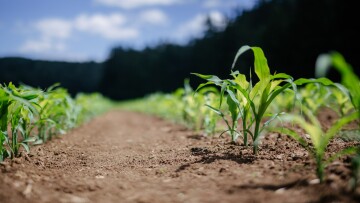
FUI-Bloggen
FUI är förkortningen för forskning, utveckling och innovation. I FUI-bloggen skriver Yrkeshögskolan Novias personal om sitt jobb, forskning, projektverksamhet och andra betraktelser.
Blogginlägg som är granskat av Novias redaktionsråd är utmärkta med nyckelordet "Granskat inlägg".
Vi följer CC-BY 4.0 om inget annat nämns.
The Role of Blockchain in Transforming the Agri-Food Circular Economy

The current food supply chain lies at the center of a nexus of global catastrophic threats, such as environmental degradation, biodiversity loss, and the depletion of essential resources. Systemic transformation is needed to halt resource exploitation and minimize emissions incurred through the food production system. Preventing food loss is seen as one of the priority areas in the EU’s Circular Economy Action Plan, which was adopted in 2015. Moreover, the new and revised EU waste legislation [1] necessitates all Member States to execute national food waste prevention plans, monitor food waste levels, and diminish food waste at each step of the supply chain.
Blockchain technology is gaining traction as an invention that can facilitate sustainability in global supply chains. Blockchain is a distributed ledger technology that provides a platform for safeguarding and distributing data in a peer-to-peer framework through immutable and verifiable records of transactions. While the development of use cases in the realm of a shift toward circularity in the food system is still in its infancy, blockchain seems to have the potential to facilitate this transformation. The major impact appears to be related to food loss prevention as a result of pre-and postharvest optimization.
Preventing food loss during preharvest
Food can be lost early in the supply chain, during manufacture and processing, or later at the end of the chain, when restaurants, supermarkets, and households discard it. Part of the food loss occurs due to the mismatch between supply and demand. The current food supply chain system is challenged by the issue of asymmetric information which can lead to demand-supply imbalances and increased transaction costs. Hence, food loss can be prevented by increasing transparency in the supply chain and reducing the imbalances between supply and demand.
Global food supply chains are complex and require transparent communication of transactions across actors. The need for high volumes of data to be processed, along with the long period for computation and verification, leads to high overhead costs and resource loss. In the transition toward the circular economy, the volume of the transactions will be augmented, which requires an efficient real-time transaction management mechanism. Traditional systems manage data in a centralized manner and are prone to erroneous data, data distortion and cyber-attack. Blockchain accelerates food supply chain management by reducing intermediaries, reducing the friction of sharing information and securing transactions. This mechanism speeds up document processing by automatically matching data in real time, avoiding the need for manual controls and iteration.
With equal access to production information, prices can be set more efficiently, and production can be optimized. Additionally, by preserving an ongoing database of transactions, blockchain allows participants across the world to conduct due diligence on one another and securely conclude transactions without the need for intermediaries. In a blockchain-enabled agri-commerce, participants can benefit from lower-cost and faster payment options. Under the existing system, farmers often have to wait weeks for payment from one another, and traditional payment methods such as wire transfers can be expensive. Blockchain technology has the potential to reduce some of these inefficiencies. Recent Proof-of-Concept studies provided evidence of blockchain possibility for inexpensive, secure, and near-instant peer-to-peer fund transfers.
Moreover, blockchain, in a combination with other digital technologies, enables smart agriculture and improves production efficiency. Digitalization allows farmers to improve crop planting (e.g. optimising the irrigation schedule, monitoring soil and crop status) and harvesting (e.g., sensors detecting optimum harvest time, and cold storage). There are a variety of field sensors and detection devices that can be integrated with blockchain networks to enable smart agriculture including soil moisture and humidity sensors, radiation sensors, and rainfall predictors. Sensors can be mounted in a variety of locations, including seed banks, greenhouses, storage spaces, agricultural machinery, transportation system, and livestock, and the data collected can be processed in the cloud to be used for monitoring and control. Blockchain provides a platform for optimised cloud computation for such big data and a transparent mechanism for sharing processed data across the supply chain. For example, sensors can monitor the quality of seeds and fertilizer and trigger preventive actions. Blockchain also has been used for livestock supply chain management. Monitoring the medical history of cattle on a tamper-proof blockchain ledger will foster trust in farming practices and establishes credibility, especially in trade with foreign markets. In such a system, each animal is marked with a unique, ultra-long-range radio-frequency identification (RFID) tag. The tag records relevant information about the owner of livestock, livestock (e.g., DNA of animal, weight, type of farming), and treatments received (e.g. if the animal is dipped, vaccinated or received other treatments) onto the blockchain network. The recorded data will provide a secure and tamper-proof trail of each animal’s history. The secure ledger of cattle information facilitates optimal farm management and promotes trade. These data will be stored on the blockchain network and can be retrieved by all network participants.
Blockchain and postharvest optimization
Today food supply chain is experiencing resource depletion, particularly during postharvest agri-food processes, resulting in increased food waste and negative environmental consequences. Food spoilage and waste are caused by a mixture of microbiological, enzymatic, chemical, and mechanical factors. Hence, the development of efficient processing and logistic systems in food supply appears to be more essential than ever. Digitalization and technological improvements contribute to reducing food waste and achieving optimized supply chain management. The efficiency in postharvest will be gained through access to production information across the supply chain and technological advancements in resource utilization.
Blockchain, due to decentralized and consensus features, facilitates transparent information flow in real-time across members in the food supply chain. Consensus is a decision-making algorithm that allows a collection of network participants to achieve an agreement quickly and efficiently, ensuring the system’s smooth operation. Furthermore, blockchain technology is built upon the unanimous mechanism in which any block of data to be added from each node must get majority voting otherwise the block cannot be recorded into the network. Each transaction is updated simultaneously, and the changes propagate immediately in the network. Hence, it is hard to make alternations without consent from the majority of participants in the network.
Automation is another feature of blockchain that facilitates production optimization and helps prevent food waste. Automation in blockchain-based solutions is achieved using smart contract mechanisms. Smart contracts are programs embedded on a blockchain network that run when certain criteria are met. The core objective of a smart contract is to deploy the contractual clauses inside a combination of software and connected software so as to prevent breaching the contract. The fusion of smart contracts and blockchain environment leads to an ingenious, automated, and immutable framework. While blockchain offers a robust platform to store and monitor data transactions, a smart contract executes the business logic (triggered by predefined criteria) and controls access allocation.
Digital agri-food solutions such as the Internet of Things (IoT) and Artificial Intelligence (AI) can be integrated into the blockchain environment enabling food processors and farmers to improve food production and food safety, as well as reducing waste while maintaining economic gains. Examples of postharvest solutions include ‘smart packaging’, which changes colour as food spoils, or RFID sensors, which detect potential sources of food contamination along the food chain.
Other issues with the circular economy are the quality assurance of recycled biomass and the traceability of food recalls. The interconnectedness and dispersion in the food supply network generate vulnerabilities if food items cannot be monitored throughout every step of the chain. The vulnerability of food systems is primarily due to the perishable nature of products which demand accurate traceability to meet expected standards of quality and safety. Blockchain has the potential to improve traceability in food supply chains and permit better food security. As the data stored in a blockchain network is immutable and built on the consensus of the network members, unauthorized alterations are reduced, which ultimately assists in preventing fraud. Granularity offered by blockchain-based traceability in the event of food recalls, allows for avoidance of bulk recollections of all distributed products, diminishing food waste, and overall financial costs.
Concluding remarks
Whilst the Action Plan promotes the use of digital technologies for tracking, tracing, and mapping bio-based resources, the role of blockchain, in the transition towards a circular economy in the agri-food supply chain, has received scant attention in the research literature. Extant Proof of Concept (PoC) studies provide early evidence on the potential of the blockchain to contribute to the shift toward a circular economy in agriculture and food production.
The blockchain serves as a platform for agricultural automation and a link between digital and conventional agri-food production. The future of a sustainable food system may be dependent on how the supply chain is optimized. Blockchain has the potential to alleviate information asymmetry and improves the supply-demand balance. It also enables digitalization and increases eco-efficiency in food production. Importantly, blockchain technology has been largely examined for food traceability purposes. The traceability function of the blockchain is essential for monitoring the sources of recycled biomass and how the associated risks are mitigated.
While blockchain holds the capacity to be utilized for a transition toward a circular food system, the technology is still fraught with more general technical issues including high energy consumption, limited scalability, and high establishment costs. Moreover, most blockchain-based solutions are currently at the PoC phase, however, once large-scale pilots confirm the significance of blockchain in accelerating the transition toward a circular economy, mass adoption will follow.
[1] Directive (EU) 2018/851 of the European Parliament and of the Council of 30 May 2018 amending Directive 2008/98/EC on waste.
FUI-Bloggen
Blogginlägg som är granskat av Novias redaktionsråd är utmärkta med nyckelordet "Granskat inlägg".
Vi följer CC-BY 4.0 om inget annat nämns.
Ansvarsfriskrivning: Författaren/författarna ansvarar för för fakta, möjlig utebliven information och innehållets korrekthet i bloggen. Texterna har genomgått en granskning, men de åsikter som uttrycks är författarens egna och återspeglar inte nödvändigtvis Yrkeshögskolan Novias ståndpunkter.
Disclaimer: The author(s) are responsible for the facts, any possible omissions, and the accuracy of the content in the blog.The texts have undergone a review, however, the opinions expressed are those of the author and do not necessarily reflect the views of Novia University of Applied Sciences.
Posta din kommentar
Kommentarer
Inga har kommenterat på denna sida ännu